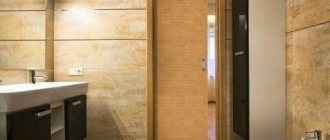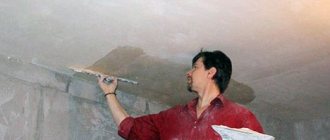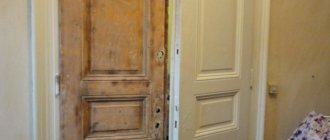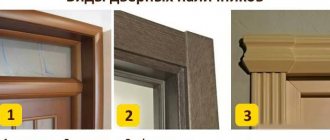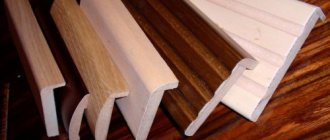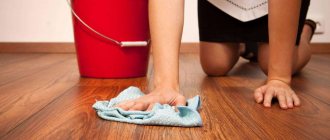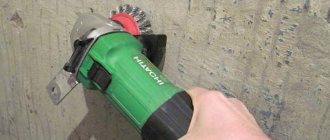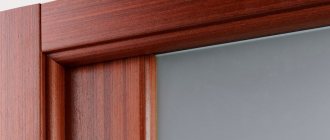Types of paints for interior doors
You can paint wooden doors with varnish to preserve the texture.
Paints and varnishes decorate the door leaf and protect it from high humidity and rotting. The service life of the frame and sash increases, the door gets a new beautiful look. If the interior block is in good technical condition, painting the door leaf yourself can be easily done using various wood compounds.
Before work, prepare the surface, putty cracks and chips, then clean it with sandpaper. The primer serves to bind the area to be painted with the paint layer.
Enamels form an outer layer that gives the surface:
- shine;
- smoothness;
- color;
- resistance to environmental influences;
- additional strength;
- chemical resistance.
Varnishes favorably highlight the wood texture or form a transparent layer on the surface for additional shine.
Water-based glossy paint
The main types that are used for interior openings:
- water-based paints;
- moisture-resistant compounds;
- glaze coatings;
- varnishes.
When choosing, take into account the material of the canvas, the presence of old coatings, and the color of the existing paint. Sometimes you need to apply the composition several times to cover and recolor a rich color, especially if you use light colors. Paint and varnish materials are applied 2–3 times, with each layer allowed to dry. Sometimes it needs to be sanded further before applying the next one.
Water-based
This variety refers to water-dispersion paint compositions. It is an emulsion suspension consisting of small polymer particles, water and coloring pigments. Emulsion grains act as the basis of the mixture, but are in an undissolved state.
Emulsions used for production:
- acrylic;
- latex;
- silicate moisture resistant;
- silicate with the inclusion of minerals;
- hydrophobic polyvinyl acetate.
Latex paint is resistant to detergents.
The properties and qualities of water-based groups depend on the components in the composition. This paint for wooden doors applies smoothly to various surfaces, except for those doors that have a glossy coating applied previously. It is good to use for printing stencils when decoratively repainting canvases.
Qualities of water-based paints:
- low resistance to moisture, used for door leaves in living rooms where it is dry;
- easy to pigment, so different colors and shades are obtained from a white base;
- protect fabrics from ultraviolet radiation;
- have an antifungal effect;
- do not crack or fade over time and form a durable film.
Water-dispersed materials dry quickly, do not have a strong odor, and you can paint interior doors made of wood, plastic, MDF, plywood, and chipboard. Aqueous polymer emulsions are demanding for transportation and storage.
Moisture resistant
Acrylic paint is suitable for interior and exterior work.
To repaint doors in the house, colorful materials are used that form a protective film against surface moisture. These water-based compositions are used for linens in bathrooms, saunas, and kitchens. The resulting coating is vapor permeable. A matte, even layer hides small defects.
Polyacrylates (butyl, ethyl and methyl acrylates), resins and copolymers are added to the paint composition to obtain a durable film. Antiseptic modifiers prevent acrylic paint from changing color in high humidity conditions. The white base is colored using dyes for the water-dispersion group.
Properties of acrylic moisture-resistant paint:
- good adhesion to the door surface;
- continuous coating (high hiding power);
- environmentally friendly product;
- beautiful appearance;
- economical consumption;
- long period of operation.
Acrylic compounds are diluted with water, but after the film hardens they become moisture resistant. The surface is also difficult to abrade. Door paint is quick-drying and almost odorless. Such surfaces do not fade from ultraviolet rays. The disadvantages include considerable cost compared to ordinary water-based paint.
Before use, acrylic compounds are stirred well and the base is prepared. Fresh wood is impregnated with soil to secure the surface. The first layer is applied with diluted paint, the second is applied without dilution.
Glazing
Glaze paint is used to cover doors that have not previously been coated with any compositions.
Compounds are often used to paint a wooden door that has not previously been coated with paints and varnishes. The mixture includes modified and alkyd resins and oils. Glazing preserves the original appearance of the fiber pattern for a long time and increases the service life of the product. They use colorful materials to impart a natural shine, darken the natural color and reduce the surface texture.
Glazing compounds have the following effect:
- protect from the negative effects of the surrounding space;
- protect from UV rays;
- prevent the development of fungus and mold on the surface;
- decorating the plane.
Paints do not react to temperature fluctuations or high humidity. For balcony doors, such quality as frost resistance is important. Glaze is transparent, the background can be seen through it, so before use, check the result in a small area. Drying time is from 12 to 24 hours depending on temperature and humidity.
They take products for interior work to paint interior doors. The paints contain harmless components without a strong odor. External products contain synthetic substances, so they are not used indoors.
Glazing differs in the way it is painted, resulting in a rich surface color with smooth transitions. They use a different palette of dyes and apply several layers. Before applying the second and other layers, wait until the previous one has completely dried.
Lucky
The use of varnish with resins protects wooden doors from moisture.
The compositions are produced on the basis of resins; they can be synthetic or natural. Mastics are diluted with solvents, for example, acetone, ethanol, hydrocarbons, essential oils, water. Semi-liquid compositions, when dry, form a transparent film that resists abrasion, moisture, and ultraviolet radiation.
Varnishes on the surface of the canvas harden with the evaporation of a soluble substance or during an oxidative polymerization reaction.
Depending on the method of film formation, they are divided into types:
- thermosetting;
- thermoplastic.
There are solvent-free varnishes on sale; they are viscous due to oligomers, which harden when catalysts or hardeners are added.
Glossy, matte and colored compositions are used. The texture of the wood or the background of the painted canvas is visible under the varnish, so a door that has no defects on the surface is varnished.
Varnish treatment is accompanied by a pungent odor that lingers in the room for quite a long time.
Modern colored varnishes preserve the original structure of the wood and give it an original shade. Colored compounds are not used for painted surfaces, since the original color will unnaturally change. There are many colors of varnishes, some are pastel, others have a sharp and contrasting shade. Such products are more suitable for natural wood, but they can also be used to paint doors made of chipboard, MDF, and planks.
Features of painting over an old layer
At first glance, painting a wooden door over an old layer seems like a trivial matter: just go ahead and paint it.
Painting the door
But in fact, in order to paint a wooden door and get a surface that will be no worse in quality than factory painting, learn a few rules:
- The surface of the door, regardless of its condition, must be carefully prepared. Against the background of the old paint, cracks and potholes are invisible, but after applying a new layer they will appear and ruin all your efforts.
- The right choice of material for painting an interior door. It’s not just a matter of proper selection of color, surface texture or the strength of the film formed. It is important to consider the compatibility of materials. Many paints are not compatible with each other, and if chosen incorrectly, the old coating may curl or bulge when it comes into contact with the new material.
- Decide on the correct paint application technique. For doors with a complex structure, it is possible to obtain a smooth and neat surface with proper selection and combination of painting techniques and painting tools.
The last rule, common to all cases of working with paint, is to strictly follow the instructions for applying the selected paint material.
Rules for choosing paint
Acrylic paint is odorless and dries quickly.
The choice depends on the desired result and painting conditions. Interior doors are treated within the living space, so an odorless finishing product is used so as not to cause allergies or health problems.
There are several types of paints on the construction market:
- oil;
- water-dispersed;
- latex;
- acrylic;
- alkyd.
Oily ones contain oils that do not give off a strong odor. Paints are pigments based on drying oil, which acts as a solvent. Oil paint compositions can be colored or colorless. For new wooden doors, the second type is used, and previously finished ones are repainted with tinted compounds.
Water-dispersed products use water as a solvent, so they have almost no odor. Harmless products are used in children's rooms and bedrooms; during the application process they do not harm human skin upon contact.
Latex enamels are not toxic products; they do not have an unpleasant odor. The paint dries quickly, a film appears after 20 minutes, and full hardening occurs after 1 hour of waiting. The binder is styrene butadiene (synthetic resin).
Acrylic products do not smell because there are no toxins in the mixture. Acrylic-based paints are safe for people during the painting process and after drying during use. Alkyd compounds are not all odorless, but there are appropriate options. There are glossy, matte, semi-matte enamels, the use of which is recommended in rooms where people with allergies live.
Required tools and materials
Container and roller for painting doors
To clean the surface of the door frame and leaf, use a hair dryer, a grinding machine, or manually remove the layer of old paint using emery cloths. The surface is painted using a roller, brush or spray. For primer and paint you need separate brushes or roller handle attachments. You can wash used ones with solvent, but it is better to take new ones.
The roller is used on flat surfaces of the door and on long surfaces of the door opening. Hard-to-reach places are painted with brushes. The sprayer can be used if you have experience working with it. To use it, the surrounding area is covered with old newspapers or polyethylene.
To lay the canvas in working position, use an old table or special trestles - two stands made of wood or reinforcement.
Other tools:
- hammer, screwdriver, pliers;
- pallets for diluting paint, varnish, primer;
- masking tape;
- spatula, sanding machine, rags.
You will need wood putty; it is usually ready for use and packaged in small containers of 200–250 grams. Take concentrated soil and dilute it according to the instructions on the package. Paint is purchased in accordance with its intended purpose.
Sandpaper is taken No. 60 for large irregularities and No. 120 - 240 for cleaning the putty surface.
How to create imitation wood
To do this you need:
- The canvas is painted with light beige, gray or yellow paint and then dried.
- Using a brush, apply liquid soap to the surface.
- Everything is covered with dark paint, and the soap is washed off.
- If you have a veneered door, you can take note of another method. For this we use a special brush. We walk it through the soft fibers with movements that would resemble combing. The surface is painted with dyes of different colors. The texture will be changed so that the surface will have swirls that resemble wood grain. Sand the surface after it dries.
- If everything is done according to the rules, then even beginners in this business will be able to paint. But first, it’s better to practice a little so that the front side comes out perfectly.
You now know how to touch up a chip on a door and how to paint varnished doors; here it will be important to take your time and properly prepare the surface. And after applying the dye, you won’t have to think about repairing the door for a long time.
Preparatory work
In order for the door to dry faster, before painting it must be removed from its hinges and taken outside.
A new wooden door is treated with antiseptic compounds and primed. On a previously painted sash, remove the paint if it has peeled off and does not adhere well. The smooth and solid coating is not touched, only sanded with sandpaper and painted in another chosen color. Natural wood is sanded to an ideal surface.
To make it convenient to work, perform the following steps:
- the canvas is removed from the hinges, sometimes you just need to lift the sash and remove it from the hinge pin, in other cases the screws on the hinge are unscrewed;
- remove the lock, handle, decorative lining on the key cavity.
It is best to remove the old layer with a hair dryer. You need help with a spatula and sandpaper. After heating, use a spatula to pry off the paint film and remove it. The remaining particles are sanded off. You need to work carefully so as not to damage the door area.
You can use paint remover. The solution penetrates deep into the film and makes it soft, after which it can be easily removed with a spatula. The chemical method works faster, but the product is toxic; you need to use a respirator. With the use of the product, the risk of damaging the area is reduced; the solution is inexpensive.
Putty completes the preparatory stage. The canvas is leveled over the entire area or only cracks are sealed. After the putty has dried, the layer is sanded to a perfect surface.
Features of painting interior doors with your own hands
Old varnish can be removed with a sander.
When using a brush, paint in one direction to hide lint marks as much as possible. This method is almost never used due to the sloppy final result. A roller is used more often because it rolls out the paint evenly and leaves no marks. For paints based on acetone, white spirit and solvent, you cannot use a foam nozzle, as the surface will become unusable after several rollings.
There is an option to use a spray gun if the house has several doors to be painted. It is not profitable to rent expensive equipment for one unit.
If the canvas is covered with veneer, it is better not to destroy its integrity during preparation. For cleaning, use a soft rag or brush, and hard-to-reach areas are treated with fine sandpaper. Dust is removed with a brush.
Before painting, clean the floor in the room with a vacuum cleaner or carefully sweep it with a broom, then wipe it with a wet cloth so that dust particles do not settle on the painted surface.
Useful tips for beginners
For ease of work and control over dipping the tool into paint, use a paint tray.
After purchasing the brushes, it is recommended to comb them out a little and soak them in water for a while. Firstly, this will prevent fallen hairs from reaching the surface, and secondly, it will soften the stubble before work.
It is more convenient to paint the canvas if it is located in a horizontal position. This way you won’t get unsightly streaks if there is too much paint in the corners and sides of the door leaf. Many people use specially prepared sawhorses for convenience, or take the easier route and place the door on 4 stools.
Protection of fittings from smudging. This is not a whim, but a reasonable step. It is advisable to twist it and put it aside for the duration of the work, but an option to protect it is also suitable, for which it is recommended to use masking tape.
Drips resulting from painting can be easily removed if you use a sponge, and then hide its traces by going over the area with a roller.
While the painted canvas is drying, make sure that no accidental dust gets on it or that a stray midge does not stick to it. To do this, it is better to do coloring in a special workshop.
Video on how to properly paint entrance blocks in a house or apartment:
You can update interior or entrance doors in different ways. Painting without removing the old layer is the easiest and fastest method, which home craftsmen most often resort to. The result of the work: a beautiful door without much effort!
Voted over 169 times, average rating 4.6
Comments
Ira 01/30/202015:56 It’s better not to paint interior doors. the paint will stink for a long time
Grade
Add a comment Cancel reply
We recommend reading
Miscellaneous Interesting glass decoupage technique, DIY door decoration Do you want to update the decor of your favorite room, but don’t want to start again...
Miscellaneous Recommendations from professionals on choosing a door frame for interior doors To install a door, you will need to choose the right door…
Miscellaneous Main distinctive characteristics of moldings for interior doors Manufacturers offer door designs of standard sizes, ...
Miscellaneous What is the purpose of installing brushes on interior doors? To make using the interior door convenient and not separate...

